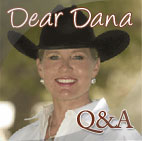Freedom of choice is key to your horse’s happiness – and reactions
HEY RAY!: This is about lost trust and resentment. I was training my horse, Connor, for trailering. Whenever he stopped in front of the trailer, I would back him up forcefully — I was trying to make the choice of either going “forward” or being “backed up forcefully.” I had thought of “backing up” as punishment. At that time, I didn’t know about SWAP and didn’t reward him for successfully backing up. Not only that, I backed him up very forcefully. If I caught up to him while I was running forward, he would get a sharp tap in the chest. Now he is resentful. How do I get him back?
— Evan Moser, Lancaster, Calif.
HEY EVAN: All is not lost. You are ahead of the game because of how clear you are about the need for change. The approach you took is one that could have worked. Many people have been successful loading horses — as well as making them do things they didn’t want to do — with punishment. Negative reinforcement will work if you’re very good at administering it and your horse is willing to accept it. If punishment brings out the worst in your horse, you will initiate a battle that, unless you win, will haunt you throughout the relationship with your horse. I feel freedom of choice is the key to your horse’s happiness. How you help him make the right choices will be what he appreciates the most about you. The approach, intention, and delivery will influence how accepting your horse will be.
The first thing we need to do is put your dressage whip away. The whip, unless used properly, will only frustrate and/or insult your horse. Connor needs to understand that anything he feels from now on actually means something. Sensation or pressure should not evoke fear or intimidation. You need to come across as harmless, but enlightening, if you expect your horse to have the necessary breakthroughs needed to S.W.A.P. (Sweet, Willing, And, Predictable).
The role you will be playing should be that of a referee. You need to know the exact rules of the game you are playing and should be inactive if the horse is doing what is expected. The tool or extension of your hand should be one that is insulated from pain.
One way you can accomplish this is by wrapping a small sponge at the end of your wand or stick with some electrical tape. This doesn’t need to be pretty, just functional. This way you can tap your horse all over until he becomes fully desensitized and accepting of the wand. Next, you should attempt to put meaning to sensation. The way you will do this, is by raising the volume (stepping up the pressure) every couple of taps until he moves. When he does, stop tapping and allow him to continue to move. You should be able to move your horse forward, sideways and backwards with the use of the wand with the sole intention of rewarding him at the end, each and every time. If you want him to stop, rub him with the end of the wand continuously until he stands quietly. This should help restore your horse’s negative perception of the aid, (whip) and restore the trust and confidence in you.
How you apply your aids is no different than how you initially start your car. Once you crank it over, allow it to continue to run on its own. Continuing to crank the starter would only result in damaging the system. Don’t reapply the aids until the horse stalls or stops. Then — and only then — should the aids be reinstated. Hopefully by this point your horse will have a different impression of your intentions when applying your artificial aids (anything held in your hand).
The next stage should be fairly simple now that we have your horse in a healthier state of mind. Remember, we are looking for the excuse to reward, not for the excuse to punish. If the horse does anything other then what we have suggested or hoped, we should ask ourselves: Is this something I can reward you for? If the answer is no, then find something that you can reward him for, i.e. backing, circling, or turning on the forehand with a reward at the end. Because horses are masters at reading body language, it is extremely important that you stay positive, regardless of which of the two choices your horse picks.
If you choose backing up as your reward-able exercise, try patting him under his jaw with the padded end instead of on his chest. Not only will you avoid bringing back bad feelings from the sharp whip, but you will help position your horse’s frame in a way where his withers will be up and his haunches will be down. This will facilitate the exercise. Before you try loading your horse into the trailer, see if you can challenge him by asking him to walk over a puddle, tarp or other obstacle that he might refuse. This will give you a chance to practice and your horse a chance to succeed without the added challenges that go along with trailer loading.
Evan, I’m confident that you will restore the relationship between you and Connor if you just give the time needed for this process to work.
Trust your instincts and stay safe,
Ray
Horsetrader columnist Ray Ariss, husband to Pippa Ariss and father of six, shares his insight into the relationship of horseand human twice each month, in print and on www.horsetrader.com. He lives and trains in “Horsetown USA”, Norco, Calif., at his bustling Starbrite Riding Academy, where he currently has 50 horses in various stages of training, including Andalusians, Friesians, Quarter Horses, Paints, Thoroughbreds, Arabs, Mustangs and more. Ray attributes his training success to the support of his wife and partner, Pippa, and a system he calls S.W.A.P., to which he credits his multiple championships in several disciplines. His passionate understanding of the “human-horse” relationship was evident when he took on the challenge of training a wild Mustang and — in just 100 days — produced the highest-priced adopted Mustang ever — $50,000. Does your “horse-human relationship” leave you with a question for Ray? Click here to submit one!
Dear Dana: Can you provide a stallion owner insight into 2010?
DEAR DANA: What advice can you give a stallion owner like me, as we look ahead to the new year? Do we do anything differently while we wait out the market for breeding?
— Ann, Pomona, Calif.
DEAR ANN: That is a very good question, and mare owners and stallion owners all over the country have the same question!
First of all, I tell mare owners that I feel there could be a shortage of show prospects over the next few years because so many people have not bred their mares. Yes, it is possible that there were too many horses at one time, but there will certainly be less now as many people have stopped or cut back on their breeding.
The other thing you could do differently — if you are able to — is adjust your price to your customers. I have offered an early booking discount to encourage people to breed their mares, as well as discounts to proven mares. I have also lowered my prices on many of my young horses to stay competitive in this market.
There are a variety of innovations and ideas that are currently being used in the breeding industry, and discounts are one of them. The promotional idea needs to fit the profile of the breeder. If you have kept an eye on my website, you will find that I offer promotions and specials often which can help make it possible for some people to continue with their horse. I also offer incentives and financing to approved buyers.
I am doing what I can to make it possible for people to breed and raise their horses or to purchase a horse, and my hope is that soon the market will be strong again!
Dana
Have your own question for Dana? If so, click here! If your question is used in “Dear Dana”, you will be entered into a monthly drawing for a FREE “Winning Strides” DVD!
Sign up for Dana’s newsletter and keep up with Dana’s updates, new products and clinic schedule! When you register, you are automatically entered into a quarterly raffle for great prizes, including a FREE personal training session with Dana! Click here to sign up now!
Golden Gal
Successful youth rider Rebecca Murray fills her passions with horses and reining
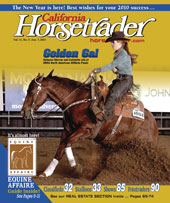
Californian Rebecca Murray and Gatolotto win the 2009 NRHA North American Affiliate Finals' Novice Horse Non Pro Level 2 division.
Horses and Reining: No Looking Back
Murray started riding when she was 4 years old and horses have been the focus of her life since then. “It just happened–my older sisters quit riding and my mom asked if I wanted to start, and I said yes,” recalled Murray, whose riding progressed to competing in pleasure and all-around classes.
Equine Affaire returns to California for its
10th year from Feb. 4-7
Just $16 gets you an all-access daily ticket to the 2010 edition of our country’s most successful and most enduring all-breed, all-discipline equine expo, Equine Affaire, which returns to Fairplex in Pomona, CA, Thursday-Sunday, February 4-7. Admission for kids age 7-12 is just $10, and tots aged 6 and under get in free.
Leslie Foxvog receives prestigious Appaloosa awards
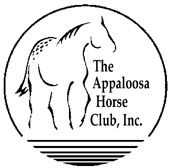 PHELAN — The Appaloosa Horse Club will honor Leslie Foxvog of Phelan, Calif., with the 2009 George Hatley Award. The award, named in honor of one of the ApHC’s founders, is decided annually by its board of directors to recognize an individual in the Appaloosa industry who contributed significantly to the growth and promotion of the Appaloosa breed within the past year.
PHELAN — The Appaloosa Horse Club will honor Leslie Foxvog of Phelan, Calif., with the 2009 George Hatley Award. The award, named in honor of one of the ApHC’s founders, is decided annually by its board of directors to recognize an individual in the Appaloosa industry who contributed significantly to the growth and promotion of the Appaloosa breed within the past year.
Foxvog has been an ApHC member for more than 10 years and actively promotes the Appaloosa breed. She is a member of several regional clubs in her area, and is currently the Calizona Appaloosa Horse Club president. Foxvog has been instrumental in Calizona ApHC’s two consecutive wins for the ApHC’s Regional Exemplary Award, which offers regional clubs the opportunity to win prizes and recognition by displaying the club’s efforts to promote the Appaloosa breed.
Californian Lucy Davis wins European Youngster Cup
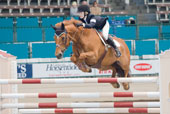
Lucy Davis and True Love win the 2009 European Youngster Cup at CSI Frankfurt in Germany.
Riding True Love, a 13-year-old Belgian Warmblood owned by Old Oak Farm, Davis jumped clear in the preliminary round, with the eighth fastest time, and then had one fence down in the next round. Her score was good enough to make the final, which featured the top 16 after the first two rounds.
The Five Easy Pieces: Exercises to take control of your horse’s body zones
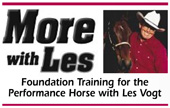 Last in a Series
Last in a Series
This time, we finish up this ongoing topic series and discuss: Putting The Five Easy Pieces Together. In the last several installments, Les Vogt has taken you through exercises of his Five Easy Pieces. When you’ve mastered them, you should be able to put any part of your horse’s body where you want it, without resistance.
Putting The Five Easy Pieces Together: It’s a great warm-up to be able to go through the Five Easy Pieces in sequence. As you’re going through the exercises you should never have to change the lateral posture of your horse. In fact, you hands should barely move as you do through the whole sequence.


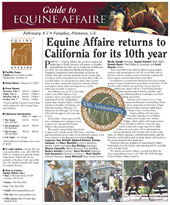
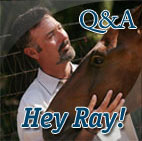
 Read Columns
Read Columns
